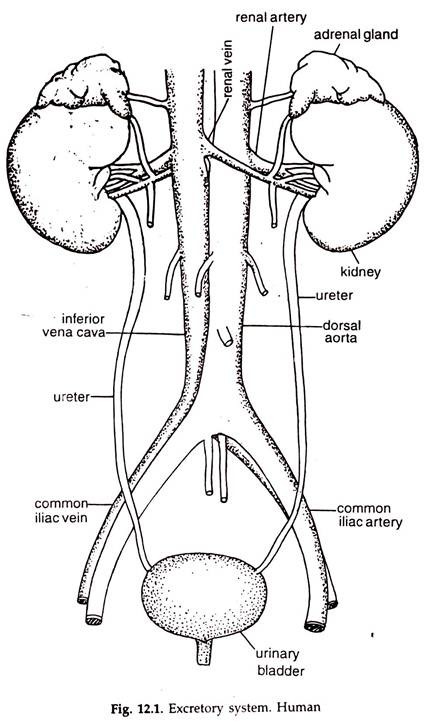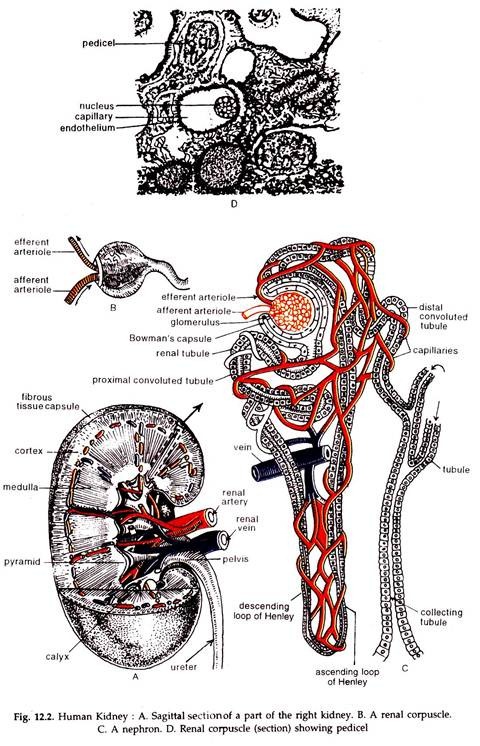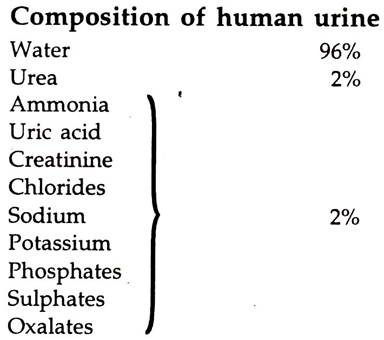In this article we will discuss about the human excretory system with the help of suitable diagrams.
The kidneys are bean-shaped (Fig. 12.1).The renal tissues are enclosed in a smooth, tough capsule. The renal tissues consist of an outer renal cortex and an inner renal medulla, several renal pyramids constitute the medulla. The base of a pyramid is placed outward and the apex or papilla, inward.
The cortical tissues extend in the spaces between the pyramids. The anterior end of the ureter enlarges to form a large space in the medially directed hilum of the kidney. Calyces, the narrow spaces, are present between the papillae (Fig. 12.2A).
ADVERTISEMENTS:
A human kidney contains about 45,00,000 excretory or filtration units, the nephrons. A nephron consists of a Bowman’s capsule at the proximal end, the rest is a long narrow tubule. The capsule is lodged in the renal cortex. The Bowman’s capsule is a two layered, hollow sphere, a part of which is pushed inside by a knot of capillaries, the glomerulus (L. glomus = ball).
The capsule and the glomerulus together are known as renal corpuscle (Fig. 12.2B & C.).
The walls of the glomerular capillaries are made of a single layer of endothelium bearing pores about 10 nm in diameter and a layer of large cells, the podocytes (Gr. pous = foot + Fr. cyte = cell) bearing primary and secondary folds, the pedicles that interlaced with each other and rest on a basement membrane lying against the endothelium (Fig. 12.2D).
The endothelial pores and the podocyte slits make the glomerular capillary wall manifold permeable than other capillaries but does not permit molecules larger than 40,000 molecular weight to pass. The walls of the Bowman’s capsule are made of a single layer of flattened cells. The inner or the visceral layer lie against the glomerulus and the outer or parietal layer is continuous with the walls of the tubule.
The walls of the tubule are constituted by cuboidal and flat cells. The tubule has three distinct zones, the proximal convoluted tubule, with the wall made of a single layer of cuboidal cells with brush borders, the middle or U-shaped loop of Henley and the last part, distal convoluted tubule joining the collecting tubule.
The cells of the walls of the tubule beyond the proximal convoluted tubule are made of cuboidal cells with a few microvilli in the first part of the descending loop of Henley and of squamous epithelium in the rest.
A collecting tubule receives several nephrons and ends in the renal pelvis. The renal corpuscles and the convoluted tubules lie in the cortex, a major part of the collecting-tubules and the loops of Henley extend into the medulla.
Blood Supply:
The kidneys receive blood from the dorsal aorta through renal arteries. On entering the kidney the renal artery divides several times into interlobular arteries, each of which subdivides into several afferent arterioles. An afferent arteriole divides into a number of capillaries to form a glomerulus.
ADVERTISEMENTS:
The glomerular capillaries receive oxygenated blood from the afferent arteriole. At the other end the capillaries unite to form the efferent arteriole, which is narrower in diameter than the afferent arteriole. The efferent arteriole breaks up and forms a dense capillary network surrounding the tubule, which join to form a renal venule.
A few venules together constitute one interlobular vein. A few interlobular veins together form the renal vein opening in the inferior vena cava. The kidney receives about one-fourth of the total blood volume per minute. The total volume of blood in human passes through the kidney in every 4 to 5 minutes.
Urine Formation:
Urine formation starts with glomerular filtration. A glomerulus is continuous with an afferent arteriole of the renal artery. The other end of the glomerulus is continuous with an efferent arteriole that sends capillaries to the tubule.
The diameter of the efferent arteriole being narrower than that of the afferent arteriole (Fig. 12.2B), causes a high filtration pressure, about 60 mm Hg in the glomerular capillaries. The glomerular blood pressure exceeds the collective pressure of capsular fluid and plasma protein osmotic pressure, both of which participate in returning fluid to the blood, by about 20 mm Hg.
Urine formation is a continuous- process. The filtration pressure in the glomerulus is sufficient to force out water, glucose, amino acids, ions, salts and nitrogenous wastes, etc. into the capsule.
Reabsorption:
Nearly all the substances in the glomerular filtrate, except nitrogenous wastes are reabsorbed in varying degrees in the tubules, depending on their concentration in the tubule. If the concentration of a substance is above renal threshold, that means the concentration in the filtrate is above the concentration level in the plasma, a certain portion of the material will be reabsorbed.
More than 90 per cent of water is reabsorbed in the tubules, sodium, chloride and bicarbonate ions in both the convoluted tubules and a part of urea in proximal convoluted tubule. Reabsorption involves both passive diffusion and active transport. In man, the volume of urine formed is about one per cent of the filtrate and this shows the magnitude of reabsorption.
Tubular Secretion:
Proximal and distal convoluted tubules, the latter playing a major role, remove creatinin, ammonia, steroids, sulphur compounds, drugs and some other materials from blood and secrete these to the filtrate. The fluid leaving the kidney for storage in the urinary bladder is urine. In human it is hypertonic to the blood.
Urobilin, a bile pigment, altered in the intestine, reabsorbed and finally excreted, imparts an amber colour to the urine. The specific gravity of urine is 1020 to 1030; it is acidic in nature.
ADVERTISEMENTS:
The specific gravity and the amount of urine produced vary with the amount of water intake, loss of body water by perspiration and other means and the amount of solid excreted. A healthy, adult man passes about 1,000 to 1,500 ml urine in 24 hours. Urine production is reduced in muscular exercise and in sleep.


